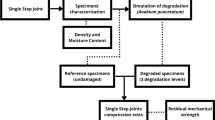Abstract
The present paper reports the results of an investigation regarding the study of the load-carrying capacity of connections with nails of small diameter pneumatically driven in timber-to-timber joints of fast-growing Argentinean Eucalyptus grandis. The effectiveness of the equations provided by Eurocode 5 for calculating the lateral load-carrying capacity of these joints was checked for the specimens exhibiting the geometrical parameters adopted by the European design rule and also for those with reduced spacing and end distances. A failure mode presenting features common to both j and k types of failure according to the criterion of the European design rule confirmed that the plastic hinges could be developed before brittle failure due to splitting or block shear occurred, even if the specimens present reduced spacing and end distances. The load-slip curves confirmed ductile behaviour for all cases. The empirical results showed that the structural design is situated on the conservative side if the equations adopted by Eurocode 5 are applied to the analysed connections when the spacing and end distances recommended by this design rule are used. The results also showed that the joint area may be decreased by up to 31 % in relation to that corresponding to the recommended spacing and end distances without reducing the load-bearing capacity below the characteristic value determined according to the European design rule.
Zusammenfassung
Dieser Beitrag fasst die Ergebnisse einer Studie zusammen, in der die Tragfähigkeit von Verbindungen aus Eucalyptus grandis aus Argentinien mit auf Abscheren beanspruchten Nägeln mit kleinem Durchmesser untersucht wurde. Die Gültigkeit der Gleichungen des Eurocodes 5 zur Bestimmung der Tragfähigkeit dieser Verbindungen wurde überprüft für Proben mit den erforderlichen Mindestnagelabständen und für Proben mit verkleinerten Nagelabständen. Der Versagensmechanismus und die Last-Verschiebungs-Beziehung zeigten ein plastisches Verhalten für alle Proben. Die empirischen Ergebnisse zeigten, dass die Anschlussfläche dieser Verbindungen stark vermindert werden kann, wenn die charakteristische Tragfähigkeit nach dem Kriterium des Eurocodes 5 berechnet wird.






Similar content being viewed by others
References
Bejtka I, Blaβ HJ (2002) Joints with inclined screws. Paper 35-7-5, Proceedings, CIB-W18 Meeting, Kyoto, Japan
Blaβ HJ (1991) Untersuchungen zur Lastverteilung in Nagel verbindungen. Holz Roh Werkst 49:21–26
Blaβ HJ (1994) Variation of load-slip behaviour in nailed joints: variation parallel to the grain. Forest Prod J 44(1):15–20
Blaβ HJ (1995) Multiple fastener joints. In: Timber Engineering STEP 1, Centrum Hout, The Netherlands, pp. C15/1–C15/8
Chui YH, Chun N (2000) Performance of wood joints fastened with power-driven nails. Proceedings of the 6th World Conference on Timber Engineering (WCTE2000), British Columbia, Canada
EN 1380 (2009) Timber structures–Test methods–Load bearing nails, screws, dowels and bolts. European Committee for Standardization, Brussels
EN 1382 (2000) Timber structures–Test methods–Withdrawal capacity of timber fasteners. European Committee for Standardization, Brussels
EN 14358 (2007) Timber structures–Calculation of characteristic 5-percentile values and acceptance criteria for a sample. European Committee for Standardization, Brussels
EN 1995-1-1 (2005) Eurocode 5: Design of timber structures–Part 1-1: General–Common rules and rules for buildings. European Committee for Standardisation, Brussels
EN 409 (2009) Timber structures–Test methods–Determination of the yield moment of dowel type fasteners. European Committee for Standardization, Brussels
EN 384 (2010) Structural timber–Determination of characteristic values of mechanical properties and density. European Committee for Standardization, Brussels
EN 26891 (1991) Timber structures–Joints made with mechanical fasteners. General principles for the determination of strength and deformation characteristics. European Committee for Standardization, Brussels
Hartl H (1995) Truss connections with dowel-type fasteners. In: Timber Engineering STEP 2, Centrum Hout, The Netherlands, pp D1/1–1/13
Hilson BO (1995a) Nailed joints. In: Informationsdienst Holz, Holzbauwerke, STEP 3. Arbeitsgemeinschaft Holze. V., Düsseldorf, pp 7/1–7/22
Hilson BO (1995b) Nailed joints I. In: Timber Engineering STEP 1, Centrum Hout, The Netherlands, pp C4/1–C4/8
INTA (1995) Manual for producers of eucalyptus of the Argentinean Mesopotamia. Forestry Group, National Institute of Technology for Farming, EEA Concordia, Argentina (In Spanish)
IRAM 9662-2 (2006) Glued laminated timber. Visual strength grading of boards, part 2: boards of Eucalyptus grandis. Argentinean Institute for Standardization and Certification, Buenos Aires (In Spanish)
ISO 3130 (1975) Wood–determination of moisture content for physical and mechanical tests. International Organization for Standardization
ISO 3131 (1975) Wood–determination of density for physical and mechanical tests. International Organization for Standardization
Johnsson H, Stehn L (2004) Plug shear failure in nailed timber connections. Holz Roh Werkst 62:455–464
Kessel MH (1995) Trusses. In: Timber Engineering STEP 1, Centrum Hout, The Netherlands, pp B12/1–B12/8
NCh 1198 (2007) Wood–wood constructions-calculation. National Institute for Standardization INN-Chile, Santiago (In Spanish)
NDS (2005) National Design Specification for Wood Construction. American Forest & Paper Association, Washington, DC
Sosa Zitto MA, Köhler J, Piter JC (2012) Embedding strength in joints of fast-growing Argentinean Eucalyptus grandis with dowel-type fasteners. Analysis according to the criterion adopted by European standards. Eur J Wood Prod 70(4):433–440
Stehn L, Bőrjes K (2004) The influence of nail ductility on the load capacity of a glulam truss structure. Eng Struct 26:809–816
Author information
Authors and Affiliations
Corresponding author
Rights and permissions
About this article
Cite this article
Sosa Zitto, M.A., Köhler, J. & Piter, J.C. Load-carrying capacity of timber-to-timber joints of fast-growing Argentinean Eucalyptus grandis with nails of small diameter laterally loaded in double shear: analysis according to the criterion adopted by European standards. Eur. J. Wood Prod. 72, 21–31 (2014). https://doi.org/10.1007/s00107-013-0748-6
Received:
Published:
Issue Date:
DOI: https://doi.org/10.1007/s00107-013-0748-6




